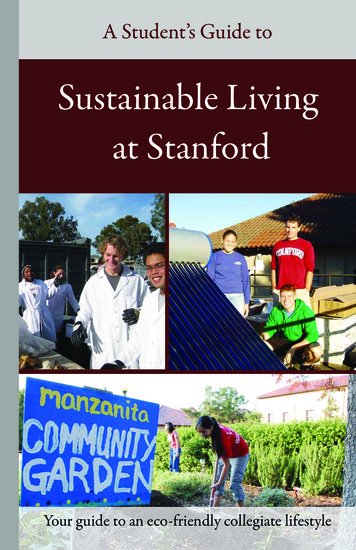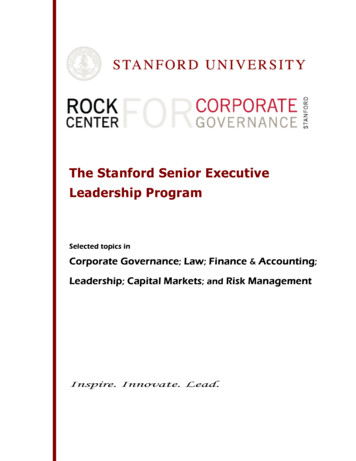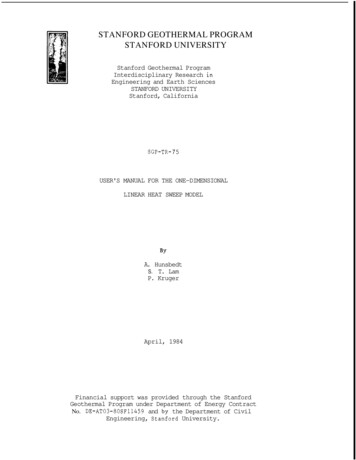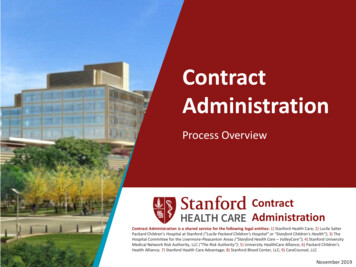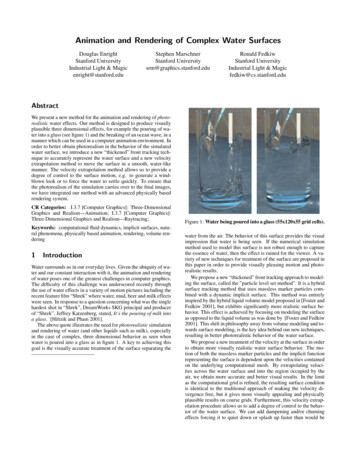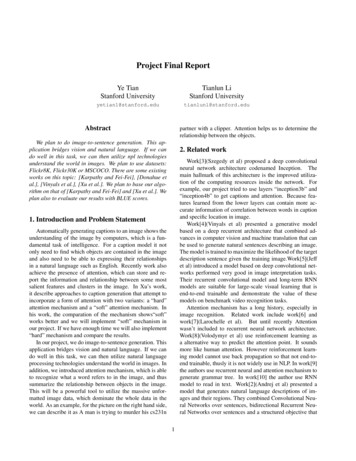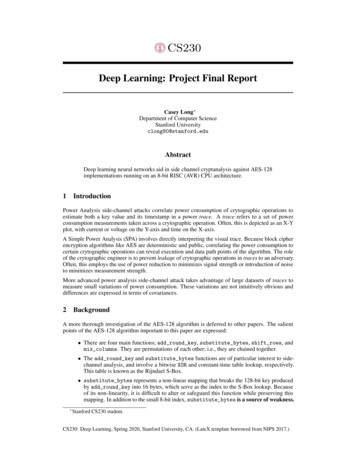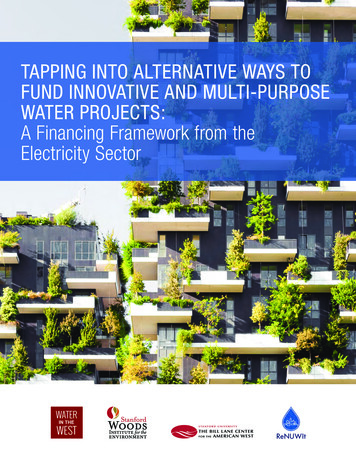
Transcription
Leadershipby Examplea 20 year outlookThe founders of the university had the vision for an institutionof higher education that would produce “cultured and usefulcitizens”. They also designed the physical campus in accordwith the natural environment of the region. In a rich history ofprofound choices, leading achievements and great commitment,we outline a period of high investment and results in the field ofenvironmental sustainability.
Leading up to Year 2000Jasper Ridge Biological Preserve is built.717376Energy Retrofit Program(ERP) begins with an annualbudget of 1 million.Students begin Stanford’srecycling program, to bemanaged by Peninsula SanitaryServices Inc starting 1993.1971: Stanford Board of Trustees becomesfirst governing body of a major academicinstitution to adopt a statement oninvestment responsibility.First Institutional ConservationProgram Grant – California EnergyCommission, received in 1979 in theamount of 127,500 for the GraduateSchool of Business80Commendation, foralternative transportation,County of Santa ClaraFirst landscape designguidelines published.Stanford founds EnergyResource ManagementGroup in facilities, layingfoundations for energymanagement today andthe first Energy Action Planin 1981.79Stanford begins trackingrecycling tonnage and diversionrates at a national level.Certificate of SpecialCongressional Recognition,for alternative transportation848789929394959697Center for ConservationBiology established.Inception of Earth Systemsprogram in School of EarthSciences.Merit Award, for Palm Driverestoration, American Societyof Landscape Architects (1995)Stanford’s Oak ReforestationProgram starts.Cogeneration plant operationbegins to power virtually all ofStanford’s campus.Tree transplantprogram initiated
A 20 Year TimelineWater Conservation, Reuse, andRecycling Master Plan developedas part of the GUP effort.Stanford becomes a foundingmember in the U.S. CommuterChoice Leadership Initiative.Transportation Demand Management programis formalized, including the Commute Club, aspart of the GUP effort.AWARDStanford receives General UsePermit (GUP) to build 2 millionadditional gross square feet ofhigh density buildings.00Project DevelopmentPlan (PDP) accompanyingguide for sustainabilitywas published, alsorevised in 2010.Clean Bay Business Award, for StanfordGolf Course Maintenance Shop and StanfordFleet Garage and Service Station (Awardreceived annually until present day)AWARDEnvironmental AchievementAward, for Environmental Healthand Safety battery recyclingand mercury thermometerreplacement programAWARDBest Workplaces for Commuters,U.S. EPA/CUTR (Award maintainedthrough 2012, until Gold award in 2013)01Global Climateand Energy Project(GCEP) is formed02AWARDOutstanding SchoolProgram Award, NationalRecycling CoalitionAWARDBy 2000, the majority of thebuildings are outfitted withelectric, steam, and watermeters, allowing Stanford tomonitor and verify resourceconsumption and efficiency.Design Award for preservationof the Frank Lloyd Wright–designed Hanna House, CaliforniaPreservation FoundationEmmett InterdisciplinaryProgram in Environment andResources is founded withinthe School of Earth Sciences.AWARDCertificate of Appreciation,Bay Area Air QualityManagement DistrictGuideline for SustainableBuildings is published withenergy and water reductionstandards for new andsignificantly renovated buildings.Waste ManagementAWARDSeismic Strengthening & HistoricRestoration Award, National Trustfor Historic PreservationWinter Closure program begins toconserve energy for two weeks duringwinter holidays when the university isofficially closed for business.Today, The recycling programdiverts 64%of waste from landfills.
AWARDCertificate of SpecialCongressional Recognition,for alternative transportationAWARDCommendation, foralternative transportation,County of Santa ClaraAWARDBicycle Friendly Community,League of American Bicyclists(Award repeated in 2005, 2006,and 2007)Whole Building EnergyRetrofit Program isestablished with 15million budget to retrofitthe highest energy usebuildings on campus.Carnegie Institution’s Global EcologyResearch Center constructedbecoming one of Stanford’s most energyefficient buildingsEnergy Conservation IncentiveProgram (ECIP) with departmentlevel energy billing introducedAWARDEnergy & Sustainability Award,for Jasper Ridge Field Station,American Institute of Architects,San Francisco ChapterAWARDGreen Business Certification, StanfordDining, one of the first such certificationsfor a university food service operation inthe United States, Santa Clara CountyUniversity Pass and VTA EcoPass available to Stanfordemployees030405First EV chargingstations installedfor visitor/commutervehiclesWoods Institute for theEnvironment launchedto coordinate and facilitateinterdisciplinary researchand action. 432.8 million raisedThe Academic Initiative on Environmentand Sustainability launches. The campaignfinished in 2011 with 432.8 million raisedfor teaching and research.AWARDAWARDAWARDBusiness EnvironmentalAward to Stanford Dining,ActerraTop 50 Award, forregional transportation,employer category, BayArea CouncilAWARDClean Air Award, BreatheCalifornia, formerly theAmerican Lung Associationof the Bay AreaGuideline for Life Cycle CostAnalysis established a method andpayback requirements for standardand sustainability features.AWARDGreen Business Award, for StanfordFleet Garage, recognizing commitment toenvironmentally responsible operations,County of Santa Clara (Award repeated in2005, 2006 and 2007)Top Ten Green Projects, for Leslie ShaoMing Sun Field Station at Jasper RidgeBiological Preserve, American Institute ofArchitects Committee on the EnvironmentSustainable Food40%of Stanford food issustainablysourced
Credit: BOORA ArchitectsFacility Operations was reorganizedinto the Department of Sustainabilityand Energy Management (SEM) andBuildings and Grounds Maintenance(BGM), which enabled sustainability tohave direct operational responsibilities.Sustainability Working Group, auniversity-wide advisory committee onsustainability policy and programs isestablished by President and Provost.AWARDAWARDLeadership Award, for nonelectedindividual or private organization,Association for CommuterTransportationThe Science and Engineering Quadis designed to be built with thehighest sustainability standards.AWARDTop Ten Green Projects, forCarnegie Institution’s Global EcologyResearch Center, American Instituteof Architects Committee on theEnvironmentGovernor’s Historic PreservationAward, for faculty houses, historichouses project category, State ofCaliforniaAWARDAWARDCommunity Partnership Award,for oak tree planting, CaliforniaState SenateGold Prize, Race to Excellence,U.S. EPA/CUTR (Repeated in2009, 2011 and 2012)Creation of the Departmentof Energy ResourcesEngineering in the Schoolof Earth SciencesAWARDBusiness Environmental Award, forStanford Dining, ActerraAWARDStanford begins participatingin national RecycleManiacompetition and pairs outdoorrecycling bins with all trash bins.Best of Universities andColleges, Race to Excellence,U.S. EPA/CUTR06Department of EnvironmentalEarth Systems Science launched.07Department of Capital Planningupdates Space Planning Guidelinesto prioritize the recovery of spacein existing campus buildings.AWARDSpecial Recognition, for oakreforestation project partnership,U.S. CongressAWARDSpecial CongressionalRecognition, for Stanford Dining,Congresswoman Anna EshooAWARDAWARDLeadership in Applying GreenBuilding Design, for StanfordDining, PG&E (2006)First greenhouse gas emissionsinventory is completed andthird-party verified; estimatedcarbon emissions fromcommuter vehicles drops below1990 level.R&DE launches SustainableFood Program andSustainable Living Program.Santa Clara Valley Urban RunoffPollution Prevention ProgramAward, for site design for stormwater pollution prevention atStanford StadiumEnergyThe SESI program willreduce campus greenhousegas emissions by 50%Stanford becomes the first universityto join California Urban WaterConservation Council.AWARDLeadership Recognition, foreliminating use of antibacterial soaps,Palo Alto Regional Water QualityControl PlantNobel Peace Prize is awarded toIntergovernmental Panel on ClimateChange, which included severalStanford researchers.
Credit: BOORA ArchitectsAWARDPreservation Design Award, forStanford Arizona Garden, CaliforniaPreservation FoundationThe Stanford’s SustainableDevelopment Study (SDS), whichdemonstrates Stanford’s land useplan and polices through 2035, waspublished in December 2008.Sustainable IT Program launched toimprove the efficiency of campus datacenters, server rooms, and personalcomputing hardware, targeting annualenergy savings of over 1 million.First Building Level Sustainability(behavioral) Program pilotedin Building 170, yielding 20%energy savings. The programcontinues today with 25 buildingsparticipating annually and averageenergy savings of 8%.Jerry Yang and Akiko Yamazaki Energyand Environment (Y2E2) Building isinaugurated and 42% more energyefficient.AWARDCollege/University RecyclingAward, American Forest andPaper AssociationAWARDAWARDBest Green Building in the BayArea, for Y2E2, San FranciscoBusiness Times08AWARDSilicon Valley Water ConservationAward, large organization categoryDomestic Potable WaterGreenopia “Three Leaves,”top 10 ranking out of 100schools surveyed09AWARDOffice of Sustainability formalized withSustainable Stanford programs of evaluationsand outreach. The Office Launchessustainability website, student green fund,annual reporting, sustainability working teamsand leadership of sustainability working group.Precourt Institute for Energy(PIE) created; TomKat Center forSustainable Energy formedAWARDGold Level Bicycle FriendlyCommunity, League ofAmerican BicyclistsGuideline for Sustainable Buildingsrevised with more aggressive energyand water reduction targets (30%more energy efficient, 25% morepotable water efficient) set for new andsignificantly renovated buildings.Top 20 ranking as an Overall CollegeSustainability Leader on CollegeSustainability Report Card, SustainableEndowments Institute (Awardedrepeated in 2010 and 2011 until theprogram was discontinued)AWARDStanford UniversityEnergy & Climate PlanDiscovery Communications HonorRoll, top 10 rankingRising to the ChallengeThroughNew High Performance Buildings,Innovations in Energy Conservation,&Energy RegenerationOctober 15, 200921% reductionin domestic water usesince 2000, despite addingover 1 million ft2.AWARDExcellence in Motion, Award ofMerit, Metropolitan TransportationCommissionAWARDInnovative TransportationSolutions Award, WTS SanFrancisco Bay Area Chapter1 PageLANDSTEWARDSHIPMAINTAINING NATURAL RICHESGREENBUILDINGSHOWCASING INNOVATIONStanford Energy and Climate Plan, October 2009TRANSPORTATIONGOING THE EXTRA MILEENERGYMOVING TO ABRIGHTER FUTUREWATERCONSERVINGPRESCIOUS RESOURCESWASTEREDUCING ANDRECYCLINGThe first edition of theStanford Energy andClimate Plan prepared foradministrative review.
438 millioninvestmentBoard of Trustees approvesStanford Energy SystemsInnovations (SESI) – a 438million investment to redesignStanford’s energy supply systemto reduce greenhouse gasemissions by 50%, reducepotable water use by 18%,and modernize the system tobe flexible to renewables andalternative energy procurement.AWARDGreen Project of the Year, forGraduate School of Business, KnightManagement Center, Silicon ValleyBusiness Journal (2010)AWARDSierra Magazine “Cool Schools” 5th place(Rank repeated in 2011)AWARDHonorable Mention, ASHRAE TechnologyAward, for Stauffer Building I laboratory variableair volume (VAV) conversion in the existinginstitutional building categoryAWARDPlatinum-Level BicycleFriendly University, Leagueof American Bicyclists (Awardrepeated 2012-2015)Whole Building Energy RetrofitProgram (established in 2004 with 15 million budget) is allocatedanother 10 million to pursueadditional retrofits based on shortpayback. The largest individualWBERP project was completed atthe Beckman Center, deliveringabout 1 million per year in energycost savings.Steyer-Taylor Center for EnergyPolicy and Finance established.1011Construction finished on KnightManagement Center, an 8-buildinghome for Graduate School ofBusiness, earning a LEED-NewConstruction Platinum Rating.AWARDAWARDNewsweek Magazine’s GreenestSchools, 2nd place in a composite ofSustainable Endowments Institute,Sierra Magazine, and other rankingsReal-time water monitoringbegins through Stanford’sWater Efficiency Program.TransportationEmployee only drive-alone ratereduced to 47%in 2013, transit ridershipincreased to 28%Stanford School ofMedicine hosts firstannual Food Summit.AWARDFirst Place, ASHRAE TechnologyAward, for the Environment and EnergyBuilding (Y2E2) in the new institutionalbuilding categoryAWARDDesign Award of Excellence, for StanfordLaw School, William H. Neukom Building,Society of American Registered ArchitectsCredit: degenkolb.com/portfolio/higher education/standford lawFacilities Energy Management groupformed to consolidate, streamline,and expand energy efficiency andbuilding program efforts.Merit Award, with Boora Architects,for the Science and Engineering Quad,Planning for a District or CampusComponent, Society for College andUniversity Planning
AWARDStanford breaks ground on new CentralEnergy Facility under the Stanford EnergySystem Innovations (SESI) program.Effective and Innovative PracticesAward, APPA, Stanford Energy SystemInnovations (SESI) program was recognizedby APPA for the innovative design of thenew heat recovery system and centralenergy facility at Stanford.AWARDAWARDGold Rating, SustainabilityTracking, Assessment, andRating System, Association for theAdvancement of Sustainability inHigher Education (AASHE) for 2012and 2013Sustainability 3.0 – acollaborative planning forumbetween faculty and staff isestablished, with a Provost’sCommittee on Sustainability tosteer progress and milestones.Second Place Sustainability Awardfor Education and Outreach, forStanford Dining, National Associationof College & University Food ServicesAWARDSierra Magazine’s “Cool Schools”,Stanford ranked in the top 10 forthe fourth consecutive year.Final Habitat Conservation Plan(HCP) and Environmental ImpactStatement published.Jerry Yang and Akiko Yamazaki Energy andEnvironment Building (Y2E2) receive Platinumdesignation in LEED Existing BuildingOperations and Maintenance.AWARDSierra Magazine “CoolSchools,” 3rd place12The annual Celebrating Sustainabilityevent focused on sustainable behaviorsand showcased tools and resources tolead a more sustainable life on campus.13AWARDStanford holds first annual CelebratingSustainability event to kick offSustainability 3.0 and showcase progresson sustainability programs (academia andimplementation) at Stanford.Platinum Level BicycleFriendly Community, Leagueof American BicyclistsStanford launches new waterefficiency and environmentalquality website.AWARDCapri (Congestion and ParkingRelief Incentives) launched throughacademic and P&TS partnership.Platinum-Level BicycleFriendly University, Leagueof American BicyclistsTransportation21%of universitycommutersbiketo workAWARDLEED for New ConstructionPlatinum certification, KnightManagement Center, home to theGraduate School of Business (GSB),the highest rating awarded by theU.S. Green Building Council (2012)AWARDGold Award, Best Workplaces forCommuters, Stanford’s transportationdemand management program.Stanford was one of 23 employersnationwide recognized in theorganization’s Race to Excellence.AWARDFinalist, Green Enterprise IT Awards,the Uptime Institute honored Stanford’scase study, one of the top five energyconsuming buildings on campus.
Sustainable Water Management Planwill be completed, which will include:Projected in 2015- 2020Campus-wide plug loadequipment inventory begin totake a detailed account of end userenergy and water use on campus.A wastewater reclamationfield study facility will beconstructed.Provost approves fourMegawatts of rooftopsolar panel installation.Plug In Electric Vehicle(PEV) network will beinstalled on campus.Science and EngineeringQuad completed.1415AWARDAWARD2013 Tree Campus USA Recognition,Arbor Day Foundation, for promotinghealthy trees and engaging studentsand staff in the spirit of conservationThe SESI project is scheduled tocome online in April 2015.UMBRS (Utility Metering, Billing,Reporting, and Sustainabilitymetrics) – a business technologyprogram will be completed,enabling the automation of datacalculation and dashboard displaysof resource usage at a building andaggregate level.»» Searsville dam and reservoir study»» A study of sustainable groundwatersupply, and potential effects ofincorporating sustainable groundwateryield into the domestic water system»» A study of converting Faculty & StaffHousing turf irrigation to Lake Water17181920The following SESI companion projects areexpected to complete during this time period:»» 4 MW of on-campus rooftopPV installation»» Upgrading of high voltagetransmission lines to the campus»» A study of deploying large scaleelectricity storage on campus»» A study of the feasibility and economics of implementing GroundSource Heat Exchange»» Determination and implementation of a procurement strategy forcampus’ grid electricity supplyCredit: /let-earth-heat-cool-your-home/2014 Green Honor Roll, The PrincetonReview, Stanford was named one of 22colleges and universities as the mostenvironmentally friendly schools in thenation, having earned 99 points in thesurvey conducted for 832 schools.16Regional Transportation Planwill be underway as an elementof the 8180 Initiative, which willinclude a study of electrifying theMarguerite and Facilities fleets.
Stanford receives General Use Permit (GUP) to build 2 million additional gross square feet of high density buildings. Stanford becomes a founding member in the U.S. Commuter Choice Leadership Initiative. By 2000, the majority of the buildings are outfitted with electric, steam, and water meters, allowing Stanford to monitor and verify resource
